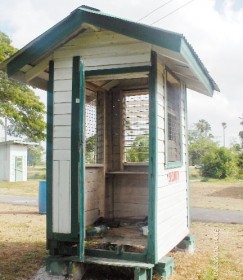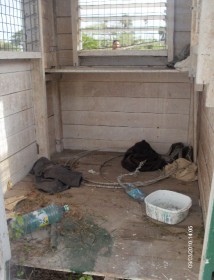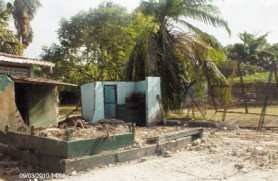By Sara Bharrat
A combination of poor decisions by the National Parks Commission (NPC) and inadequate funds is responsible for the Zoological Park’s current “prison label,” a former senior management staff says.


For more than a decade Daniel (not his real name) has watched the Georgetown zoo deteriorate as NPC, the body with overall administrative responsibility for the organisation, refused to acknowledge and address several issues which were identified. Not too long ago, frustration caused by the facility’s condition forced Daniel to leave. “I’d been working with them for more than 13 years and I just couldn’t stand it anymore,” he told Stabroek News recently. “I refused to sit there and be a part of what was happening.”
Several efforts made by this newspaper since March 10 to get a comment from General Manager of the NPC Youlanda Vasconcellos have been futile. Vasconcellos had promised Stabroek News an interview on March 11 but to date has failed to contact this newspaper or respond to any of the issues that have since been raised in two previous articles.
Stabroek News recently spoke with a zookeeper – Chip (not the employee’s real name) – who spoke out about horrible working conditions at the zoo. Employees, Chip said, still work in a high risk environment, with no insurance coverage, no health benefits and limited safety gear. In fact, zookeepers are only given two sets of uniforms and a pair of long boots every year. Chip later informed this newspaper that the zoo still does not have a proper first aid kit.
A management report done nearly ten years ago recommended a menu of health and safety measures for the Georgetown Zoo but it has still not been addressed by the NPC. “No health and safety systems in place,” said the report by then manager of the Guyana Zoo, Peter Khatoo. The report recommended that: life and accident insurance policies needed to be taken out for zoo employees; a proper First Aid Kit put in place; protective clothing like goggles, safety gloves, rain gear and helmets be made available for employees; and that staff be medically examined annually.
From early last year to now, Daniel told Stabroek News, the zoo’s staff decreased by about ten. There are currently about 23 workers remaining. In recent years, he further said, management staff have left and were never replaced. Daniel, from his experience, says that the Georgetown zoo should have at least 35 employees. This decrease in staff was also noted by Chip the zookeeper, who said that this results in additional duties for those who remain. “I can tell you, it is terrible there for the workers… I remember when I’d first started working there none of the zoo keepers then were trained. In fact even I was not trained for work in the field of zoology but I was forced to learn and learn quick after I started there,” Daniel recalled. “The zoo is basically stagnant now and there needs to be more activities. I read your first article on this issue and it is what motivated me to speak. Stabroek News captured some of the truth but there’s more to it than meets the eye.”

The maintenance crew, Daniel told Stabroek News, has been removed from the zoo. “There was no in-house maintenance,” he said, “so the place started to fall apart.” Cages, he explained, must be maintained regularly especially for the more active animals. Lack of maintenance can lead to all sorts of repercussions. Animals can escape and injure themselves or zoo workers and visitors and there is also the possibility that a section of a structure can collapse and injure or kill the animals.
In the 2000 management report, more than 30 repairs were listed to be done on cages. The number of repairs to be done throughout the zoo makes it important to have a permanent maintenance crew.
Large trees in the compound must be continuously trimmed especially those with sizeable branches that hang over cages, Daniel stressed. Recently, Cage 35 in the Georgetown zoo was damaged when a tree branch collapsed on it. However, when Stabroek News visited the zoo for a second time last week it appeared as though the cage was being fixed.
Inadequate funding, Daniel emphasized, is at the root of many of the zoo’s problems. The Georgetown zoo gets an average of $30 million from the NPC annually and it generates an average of $18 million. These figures fluctuate from year to year, but more than $70 million would be required to adequately manage the facility. Approximately 80% of the funds at present go to wages and the remainder is distributed for food and maintenance costs.
The money allotted for food feeds the non-carnivorous animals; the zoo’s predators are given “road kill.” This has been the zoo’s practice for several years. In his time, Daniel said, the “road kill” was usually screened before it was fed to the animals. “If they don’t pick up road kill then those carnivores don’t get to eat,” he said. This culture of feeding the animals “road kill” was also confirmed by Chip the zookeeper. However, Chip says that once the meat “looks good” then it’s fed to the animals.
Daniel also opined that the Georgetown zoo should be relocated. The current location, he said, can be kept as an educational facility. “While NPC is the supervisory body which is responsible for approving recommendations by the zoo’s management, Office of the President is responsible for it… I wish you luck with getting a comment from them,” Daniel said.
With regard to the facility’s security system, the report said that in 2000 there were eight employees designated as security guards. There are three eight-hour shifts distributed among them as follows: one guard from 8 am to 4 pm, two from 4 pm to 12 am and three from 12 am to 8 am. Sometimes three guards work the middle shift. This is still the system in use at the Georgetown zoo.
It was recommended by the management report that there be a constant flow of communication between guards and their supervisor, contact should be made at least every two hours; guards should be acquainted with animals and be able to restrain animals if an escape occurs during the night; a patrol guard should be present during the day to prevent visitors from interfering with animals and enclosures.
Security guards, Stabroek News also learnt from Chip, are ill equipped to deal with animals in the case of an emergency. Recent visits to the zoo revealed that the lone guard on duty from 8 am to 4 pm is stationed at the gate and collects copies of receipts for entrance fee from visitors.
Shortly after 4 pm, there is no sign of the second guard that is supposed to report for duty. The front section of the zoo is more active, employees can be seen carrying out their duties but moving deeper into the compound it becomes more and more deserted. In fact, persons can go behind barriers, touch animals and carry out all sorts of destructive activities without being noticed. Touching animals is dangerous for both the animals and visitors. In fact there are several diseases (referred to as zoonoses) which can be transmitted by such contact and precaution should be taken to ensure that animals are not petted or otherwise touched. This is only one of several reasons why it is important for the zoo to have a strong and smoothly functioning security system. There is a lone security booth midway into the compound but it appears to be in a state of disrepair.
The report was compiled by the zoological park’s management team at the time and presented in early July 2000. The team included Khatoo, Deputy General Manager Mahadeo Ramdas, Kitchen/Market Supervisor Rayman Wong, Animal Health Supervisor L. Dowdridge, Animal Supervisor Daniel Donald, Nature School Teacher Donald Gunraj and Stock/Accounts/ Typist Clerk I. Mulchand. The report is entitled Guyana Zoo 2000 – Operations, Management and Recommendations.








